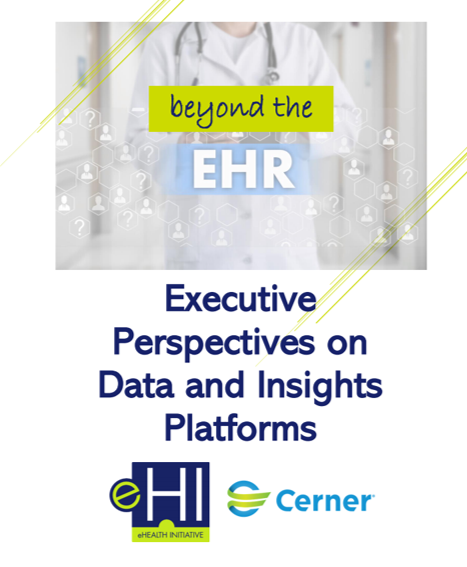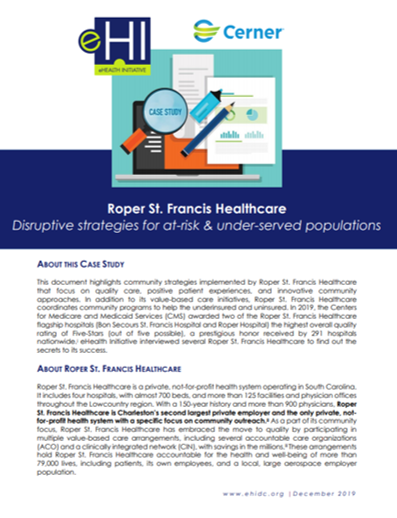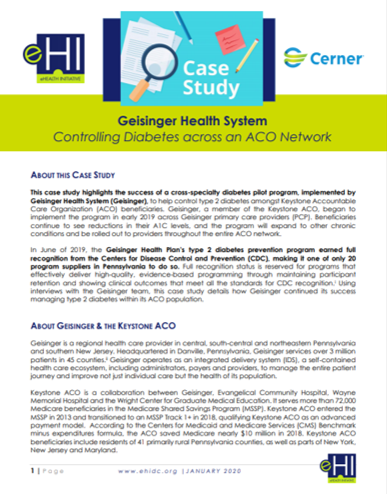BHCOE Telehealth Standards Checklist
The standards for telehealth accreditation includes guidance for areas of review for accreditation applicants. All accreditation activities involve narrative, written description and explanation of policies and procedures, documentation, documentation of usage and demonstration.
PwC Report : Beyond IT: Why the regulatory push toward interoperability requires whole organizational responses from providers, payers
This PwC report discusses the regulatory push by CMS and the Office of the National Coordinator for Health Information Technology to shift the way the healthcare system shares data, moving from a system where healthcare organizations may share data under HIPAA to one where they must share data. This has immediate and long-term implications for payers and providers faced with a healthcare infrastructure not built for interoperability. Read more at the link below!
COVID-19 Resources: Member Developments

Recent eHI Member Actions:
- AHIMA - New ICD-10-CM Code for COVID-19 (Link)
- AAFP (AMERICAN ACADEMY OF FAMILY PHYSICIANS) - AAFP Raises Pressure for Federal Response to COVID-19 (Link)
- ACOG - Are Pregnant Women at Increased Risk for COVID-19? (Link)
- ACS (AMERICAN CANCER SOCIETY) - American Cancer Society Suspends All Events until Mid-May (Link)
- AllSCRIPTS - How to Streamline Telehealth Implementation for Safer COVID-19 Patient Encounters (Link)
- AMAZON WEB SERVICES - Can Cloud Computing Cope With COVID-19 Demands? (Link)
- AHA (AMERICAN HEART ASSOCIATION) - What Heart Patients Should know about COVID-19 (Link)
- AMERICAN COLLEGE OF RADIOLOGY - Expert Radiologists Developing an AI Solution to Detect COVID-19 (Link)
- AMERICAN COLLEGE OF PATHOLOGISTS (ACP) - COVID-19: An ACP Physician's Guide (Link)
- BCBS (Blue Cross and Blue Shield) - Companies Announce Coverage of COVID-19 Testing for All Members (Link)
- BOOZ ALLEN HAMILTON - NIH Selects Booz Allen to Provide Services to Support Infectious Disease Research like COVID-19. (Link)
- CERNER - Cerner's approach to the COVID-19 pandemic (Link)
- CHANGE HEALTHCARE - As the COVID-19 Evolves, Change Healthcare Mobilizes Task Force to Take Swift Action to Protect Your Data. (Link)
- CHRISTUS HEALTH - CHRISTUS Health Statement Regarding COVID-19 (Link)
- COLORADO RHIO - While Practicing Social Distancing CORHIO Remains Fully Operational--Providing Uninterrupted Data Exchange for Colorado. (Link)
- EHNAC - EHNAC’s Executive Director, Lee Barrett, Comments on Finalization of HHS Rules on Interoperability and Data Blocking Regulations (Link)
- ELI LILLY - Lilly Co-develop Antibody Therapies for the Treatment of COVID-19 (Link)
- GOOGLE CLOUD - Google Cloud Cancels its Next Conference Due to COVID-19 (Link)
- HEALTH CATALYST - Health Catalyst Announces Three COVID-19 Solutions for U.S. Clients at No Incremental Cost for the Remainder of This Year. (Link)
- HEALTH CURRENT - How Health Current is Helping During the COVID-19 Crisis (Link)
- HEALTHIX - Healthix Releases a List of Participants Currently Testing For COVID-19 (Link)
- HOGAN LOVELLS - “Families First Coronavirus Response Act” Could Mean Massive Changes for Employers Nationwide (Link)
- INOVALON - How Inovalon is Responding to COVID-19 (Link)
- INTERSYSTEMS - Intersystems Provides Hospitals with Functionality to Screen for COVID-19 with TrakCare . (Link)
- LIFEWIRE - Deploying Telehealth for COVID-19 (Link)
- MARSHFILED CLINIC - COVID-19: What You Need to Know (Link)
- MAYO CLINIC - COVID-19: Flattening the Curve (Link)
- MGMA - MGMA COVID-19 Action Center (Link)
- NATIONAL ALLIANCE OF HEALTH CARE COALITIONS - Employer Town Hall on the Coronavirus (Link)
- NORTHWELL HEALTH - Staring Down the Coronavirus (Link)
- OHIO HEALTH - Ohio Health Officials Address Mental Health During COVID-19 Pandemic (Link)
- PROVIDENCE ST. JOSEPH - Providence St. Joseph Health Offers Coronavirus Lessons from Treating 'Patient One' in the U.S. (Link)
- STRATEGIC INTERESTS - COVID-19 Monitoring and Surveillance Solution (Link)
- UCHICAGO MEDICINE - Coronavirus Disease 2019 (COVID-19) Information and Resources (Link)
- UNITED HEALTHCARE (UHC) - Helping You Stay Informed About Coronavirus (Link)
- WELLMARK - Important Health Plan Benefits Updates Regarding COVID-19 (Link)
- ZIPNOSIS - Find Out Your Risk Level of Contracting COVID-19 Zipnosis. (Link)
Preparing for Coronavirus to Strike the U.S.
Preparing for Coronavirus to Strike the U.S.
As the new human coronavirus spreads around the world, individuals and families should prepare—but are we? The Centers for Disease Control has already said that it expects community transmission in the United States, and asked families to be ready for the possibility of a “significant disruption to our lives.”
Be ready? But how? It seems to me that some people may be holding back from preparing because of their understandable dislike of associating such preparation with doomsday or “prepper” subcultures. Another possibility is that people may have learned that for many people the disease is mild, which is certainly true, so they don’t think it’s a big risk to them. Also, many doomsday scenarios advise extensive preparation for increasingly outlandish scenarios, and this may seem daunting and pointless (and it is). Others may not feel like contributing to a panic or appearing to be selfish.
Forget all that. Preparing for the almost inevitable global spread of this virus, now dubbed COVID-19, is one of the most pro-social, altruistic things you can do in response to potential disruptions of this kind.
Best Practices
- Get a flu shot - The flu shot helps decrease the odds of having to go to the hospital for the flu, or worse yet, get both flu and COVID-19; comorbidities drastically worsen outcomes.
- Stock up on supplies -Stock up supplies at home so that you can stay home for two or three weeks, going out as little as possible.
- Help people stay at home - If you are in a position of authority, that means figuring out how to help people stay at home, by preparing for and allowing for remote work, or allowing for future work to make up for missed days and other similar plans.
- Keep your hands clean - Washing your hands often, using alcohol-based hand-sanitizer liberally and learning not to touch your face are the most important clinically-proven interventions there are.
- Keep a reserve of prescriptions and medications - If you need prescription or other medications, it’s a good idea to stock up if possible—if for no other reason than to avoid pharmacies, both to reduce their burden and also to not be in the same line as people who may be ill.
The full Scientific American blog article can be viewed at this link.
Reports: Future and Current Implementations of Data & Insights Platforms
|
|
|
|
Reports:
Beyond the EHR Executive Perspectives on Data & Insights Platforms –
This report surveyed leading executives in the healthcare industry critical importance of having a data and insights platform to manage their patient and consumer populations. Data and insights platforms are helping healthcare stakeholders manage large volumes of data amongst and between systems, while connecting members of a care team, including the actual patient. Data will continue to be the most valuable asset in managing current and future business models. Read the Full Report Here.
Roper St. Francis Case Study –
This case study highlights community strategies implemented by Roper St. Francis Healthcare that focus on quality care, positive patient experiences, and innovative community approaches. In addition to its value-based care initiatives, Roper St. Francis Healthcare coordinates community programs to help the underinsured and uninsured. eHealth Initiative interviewed several Roper St. Francis Healthcare to find out the secrets to its success. Read the Full Report Here.
Geisinger Health System Case Study: Controlling Diabetes across an ACO Network –
This case study highlights the success of a cross-specialty diabetes pilot program, implemented by Geisinger Health System (Geisinger), to help control type 2 diabetes amongst Keystone Accountable Care Organization (ACO) beneficiaries. Beneficiaries continue to see reductions in their A1C levels, and the program will expand to other chronic conditions and be rolled out to providers throughout the entire ACO network. Read the Full Report Here.
Geisinger Health System Case Study: Controlling Diabetes across an ACO Network
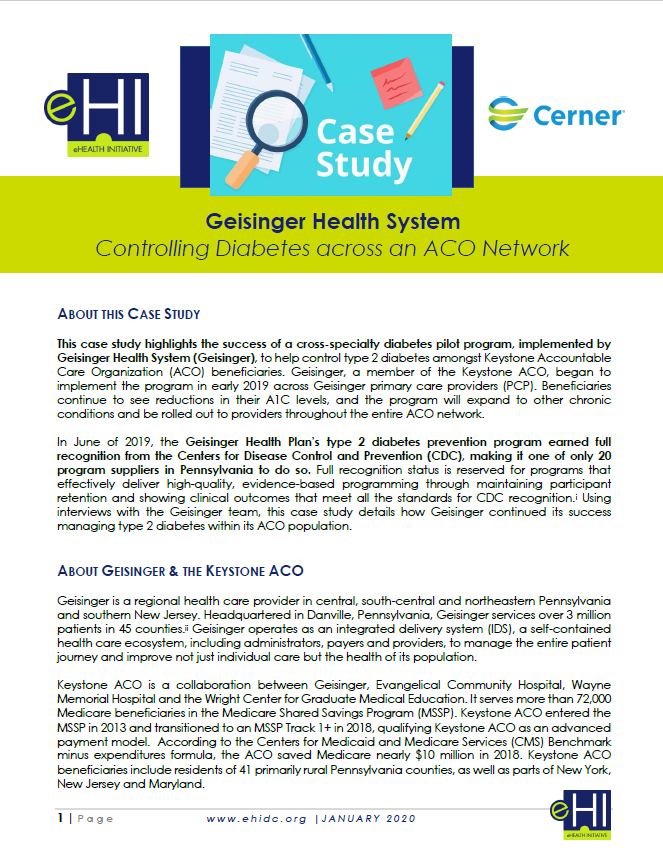 This case study highlights the success of a cross-specialty diabetes pilot program, implemented by Geisinger Health System (Geisinger), to help control type 2 diabetes amongst Keystone Accountable Care Organization (ACO) beneficiaries. Geisinger, a member of the Keystone ACO, began to implement the program in early 2019 across Geisinger primary care providers (PCP). Beneficiaries continue to see reductions in their A1C levels, and the program will expand to other chronic conditions and be rolled out to providers throughout the entire ACO network.
This case study highlights the success of a cross-specialty diabetes pilot program, implemented by Geisinger Health System (Geisinger), to help control type 2 diabetes amongst Keystone Accountable Care Organization (ACO) beneficiaries. Geisinger, a member of the Keystone ACO, began to implement the program in early 2019 across Geisinger primary care providers (PCP). Beneficiaries continue to see reductions in their A1C levels, and the program will expand to other chronic conditions and be rolled out to providers throughout the entire ACO network.
In June of 2019, the Geisinger Health Plan’s type 2 diabetes prevention program earned full recognition from the Centers for Disease Control and Prevention (CDC), making it one of only 20 program suppliers in Pennsylvania to do so. Full recognition status is reserved for programs that effectively deliver high-quality, evidence-based programming through maintaining participant retention and showing clinical outcomes that meet all the standards for CDC recognition. Using interviews with the Geisinger team, this case study details how Geisinger continued its success managing type 2 diabetes within its ACO population.
Inside the 2019 Forbes Healthcare Summit
Inside the 2019 Forbes Healthcare Summit
Healthcare is a $3.75 trillion dollar industry that touches every aspect of our lives. It’s also facing a number of challenges, from rising drug prices and the fragmentation of medical records to antibiotic resistance and more.
At the eighth-annual Forbes Healthcare Summit, which took place in New York City December 4-5, the brightest minds in healthcare converged to find solutions to these and other challenges facing the healthcare industry. Here, learn about key takeaways they shared on the future of healthcare for the brain, body and business.
Best Practices
- Eradicating the Mental Health Stigma - In an engaging discussion moderated by Dr. Mehmet Oz, media personality Charlamagne tha God, former congressman Patrick Kennedy, and NFL wide receiver Brandon Marshall discussed their own struggles with mental health and the importance of reducing the stigma around it so that people can get the help they need.
- Replacing Antiquated Regulations with Market-Friendly Policies - Seema Verma is the administrator of Centers for Medicare & Medicaid Services, but she doesn’t think her office has all the answers in healthcare. “Government is not the solution, and government is often the problem,” she said. Her team spends a lot of time unraveling past policies that no longer apply to the way healthcare works today, she said. Though Verma doesn’t always think government is the solution, she does think it can nudge the system toward more free-market principles—such as an increased emphasis on price transparency for medical treatments and drug prices.
- Improving Patient Care with Better Data - Forty years after founding Epic, billionaire CEO Judy R. Faulkner shared a rare look inside the clinical database and healthcare software company. Considering the future of electronic health data, she predicts a Cambridge Analytica-esque challenge: the risk that family members’ data will be compromised by a members’ data authorization.
- Saving Costs by Focusing on Primary Care - Moderator Moira Forbes joked with Sir Andrew Witty, President of UnitedHealth Group and CEO of Optum, about the mystery surrounding his company. “It is one of the biggest healthcare companies that no one knows anything about,” she said. Yet while many people may not know the inner workings of Optum, it touches millions of healthcare consumers across the U.S. What makes the company so profitable? A focus on efficiency without compromising patient care, Witty said.
- Bring Technological Innovation to Emerging Markets - Partners in Health cofounder and Harvard Medical School professor Paul Farmer reflected on progress he made in 11 resource-poor countries the past 32 years, tackling widespread diseases like AIDS, tuberculosis, ebola and malaria. Asked what new technologies have been most critical in his mission, he emphasized that definitions of “technology” in healthcare should include vaccines, therapies and diagnostics—not just devices and gadgets.
- Empowering Patients with AI and Telecommunications - How do you help patients make better health choices? Empower them to take control of their health with telemedicine, three digital health companies said.
The full Forbes article can be viewed at this link.
Want To Improve The Social Determinants Of Health? Here Are 8 Solutions
Want To Improve The Social Determinants Of Health? Here Are 8 Solutions
This wasn’t your typical discussion about social determinants of health. Today at Day 2 of this year’s Forbes Healthcare Summit in New York City, one of the sessions bore the title, “Four Solutions to Improving the Social Determinants of Health, Right Here, Right Now.”
Yes, that’s the word “solutions” in the title. Not “problems” or “99 problems” or “yeah, such is life.” Social determinants of health (SDOH) are the “conditions in the places where people live, learn, work, and play” that “affect a wide range of health risks and outcomes,” according to the Centers for Disease Control and Prevention (CDC). It’s been established over and over again that your environmental, social, job, and economic situations can greatly affect your health. In the words of Spandau Ballet, this much is true.
So, rather than waste any more words, let’s get to the solutions that the panel discussed:
Best Practices
- Improve people’s diets and access to healthy food - Since diet can affect so many aspects of health, it’s not surprising that one of the solutions that emerged involved food. Another panelist, Jean C. Accius, Ph.D., Senior Vice President of AARP, emphasized that reducing food insecurity can have a “ripple effect,” because locations with food insecurity also have higher levels of diabetes and other chronic diseases.
- Improve the physical environment such as increasing housing options, transportation options, and parks - Many of AARP efforts have focused on creating more “age-friendly communities.” We need to “think about how to create more livable communities.” That includes ensuring “greater housing options and greater transportation options.”
- Improve access to the Internet - These days, there’s much talk about the possibility of developing mobile and Internet-based approaches to improve the health of communities. Ah, but there’s one problem with that. Many people still don’t have reliable access to the Internet or have experience navigating the Internet.
- Better understand the needs of individuals and bring care to them - All of the panelists agreed that healthcare needs to better understand the needs of patients. Not patients as one big glutinous mass, but as a range of different individuals.
- Integrate health care with retail - One panelist offered the possibility of “healthcare getting together with retail. Integrating retail more with the healthcare system.”
- Develop and use technology to bridge the gaps in social determinants - Find ways to develop and use technology to overcome current gaps and disparities in SDOH. The other panelists talked about how technology can help better understand what consumers need and want.
- Re-structure financial incentives to motivate addressing social determinants - The panel briefly discussed a seventh key solution: re-structuring financial incentives to further motivate the aforementioned solutions, a solution to help other solutions so to speak. “it is hard to get someone to do something when their salary depends on them not doing it.”
- Changing the focus of healthcare in general - The emphasis of healthcare has to turn a completely new direction. There is an “urgent need for healthcare to better address social determinants, which is 80% of health. Too long has social determinants been relegated to the end of a meeting or conference."
The full Forbes article can be viewed at this link.
ICD-10-CM Coding for Social Determinants of Health
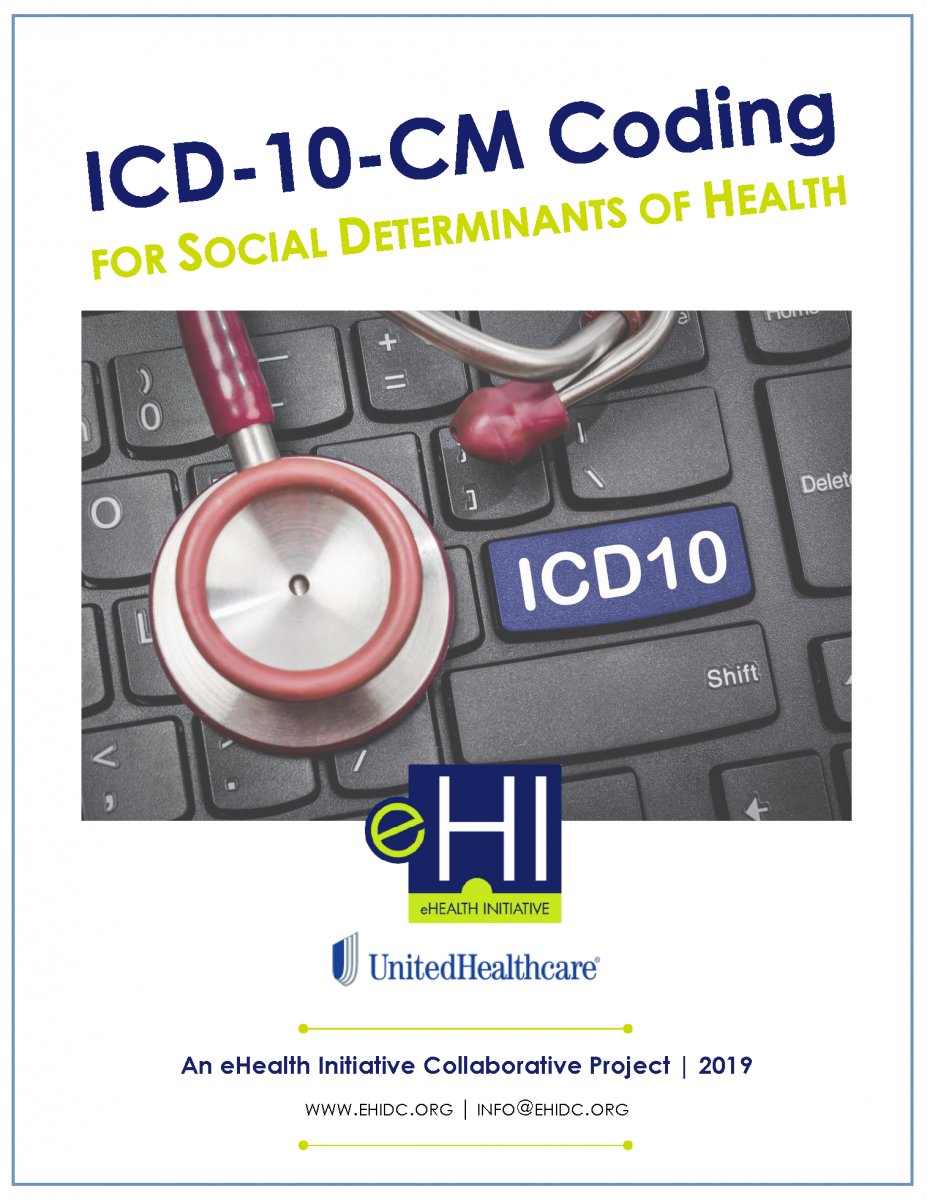 In Summer of 2019, eHealth Initiative and UnitedHealthcare’s National Strategic Partnerships Division convened a collaborative meeting of leaders from payer organizations and other stakeholder groups to address the use of ICD-10-CM codes for capturing social determinants of health (SDOH) data. This meeting marked a significant milestone in the shift to value-based care. Despite the competitive nature of healthcare, the private sector is working together to address factors pertinent to patient care and well-being in a sustainable, scalable manner. The group discussed the need for better education of provider and billing coders on the value of collecting and using SDOH data and identified strategies to accomplish this task:
In Summer of 2019, eHealth Initiative and UnitedHealthcare’s National Strategic Partnerships Division convened a collaborative meeting of leaders from payer organizations and other stakeholder groups to address the use of ICD-10-CM codes for capturing social determinants of health (SDOH) data. This meeting marked a significant milestone in the shift to value-based care. Despite the competitive nature of healthcare, the private sector is working together to address factors pertinent to patient care and well-being in a sustainable, scalable manner. The group discussed the need for better education of provider and billing coders on the value of collecting and using SDOH data and identified strategies to accomplish this task:
- Develop a consistent and unified approach to communicate and assist providers and coders in utilizing existing ICD-10-CM codes for SDOH.
- Formulate a strategy and unified approach for providers and coders to assist with adoption and utilization of the proposed SDOH codes once approved.
Attendees agreed that the best strategy to communicate and promote the adoption of ICD-10-CM codes for SDOH to various stakeholder audiences was to:
- Develop this document as well as two-page communication tools for various audiences, including providers and coders. The coder tool, Transforming health care: Why including SDOH codes on claims is critical and provider tool, Using SDOH coding to transform health outcomes are available for use.
- Promote the use of the communication tools at various payer organizations through a high-level communication plan that outlines dissemination to stakeholder groups.
For a brief overview on the topic, check out our eHI Explains ICD-10-CM Coding for SDOH. Links to the provider and coder documents are forthcoming.
Implementation best practices: The best approaches to precision medicine
Implementation best practices: The best approaches to precision medicine
Precision medicine is just starting to gain ground in the healthcare industry. Most patients have yet to have medical care designed to enhance effectiveness or therapeutic value for select groups of patients, especially by utilizing genetic or molecular profiling.
But some forward-looking healthcare provider organizations have started using precision medicine in their day-to-day operations. And the number of technology vendors with precision medicine offerings is growing.
Precision medicine is indeed the future of medicine overall. And as a result, it is time for all healthcare provider organizations to start thinking about how they can incorporate the high-tech offering.
Here, executives from precision medicine groundbreaking provider organization NorthShore University HealthSystem and precision medicine technology vendors 2bPrecise, Orion Health and Translational Software offer healthcare CIOs and other leaders and IT workers key best practices and tips for implementing precision medicine technologies.
Best Practices
- Future-proofing technology and strategy - Future proofing involves a sound genomic management strategy, execution strategy, integration with multiple EHRs, machine learning, and scability.
- Data from a wide variety of labs - To ensure value is extracted across the entire organization, the precision medicine solution must be able to ingest from a broad range of data sources.
- Work closely with strategic decision makers - In order for precision medicine to work well, a high degree of fundamental knowledge, expertise and experience is needed to come up with breakthrough insights into an organization’s data.
- Playing nice with workflow - Healthcare organizations must bring genetic and genomic test results directly into the clinical workflow so they are readily available and actionable.
- Grounding precision medicine in primary care - The advanced tools and technologies available across NorthShore present a clear opportunity to strengthen the patient relationship, aid the clinician decision process, improve care and provide value in a variety of ways.
- Integration with the EHR - One organization has bridged the gap between electronic health records and genomic medicine by incorporating patients’ genetic and family history into standard diagnostic assessments
- Technology is important, culture is crucial - Be sure that a critical part of the program is to identify and educate a base of end-users that has both a defined benefit and a financial model for making the program successful. Plan for incremental steps that show real value before investing in ‘moonshot’ technology.
- The minimum viable investments - Healthcare provider organizations must focus the technology plan on the minimum viable investments in new technology to satisfy the clinical goals.
The full Healthcare IT News article can be viewed at this link.

